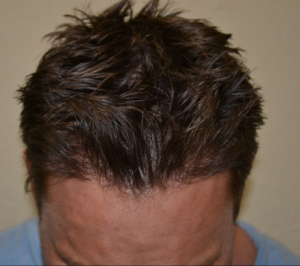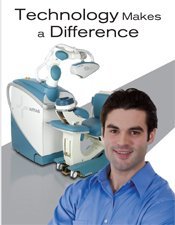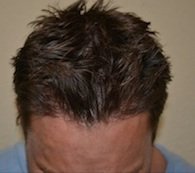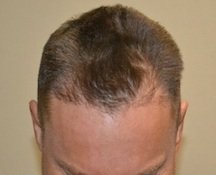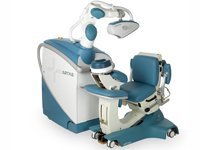The ARTAS robot is the only robotic arm controlled by the doctor that is FDA cleared in the United States for hair restoration. Dr. Bishara has been awarded most ARTAS robotic hair transplant cases in the world.
https://www.8newsnow.com/story/27258714/robotic-hair-restoration
A high-tech solution for a very common problem – by age thirty-five two-thirds of American men will have some degree of hair loss. By the age of 50, 85 percent are a lot thinner on top. A doctor becomes the patient – as he tests out a new robotic hair restoration procedure.
“Well my biggest concern is my hairline.” Robert Leonard, D.O., told Ivanhoe.
Normally Dr. Robert Leonard is the one performing hair transplant surgery but this time he is the patient, trying out a new FDA-approved robotic device to restore his hairline.
Under the control of a hair transplant surgeon, the ARTAS system uses a robotic arm and digital imaging. Every 20 milliseconds it re-calculates hair position to achieve the best results from a patient’s donor area.
“The robot will line up to each hair follicle each hair shaft either one grouping up to almost four groupings and will punch each one out by a one millimeter punch.” Matthew Lopresti, D.O., told Ivanhoe.
Unlike traditional hair transplant surgery the ARTAS robot leaves no linear scar allowing patients to wear their hair shorter at the donor site.
“I just had this technique just done a very short time ago, and my whole hair line was transplanted,” said Leonard.
Dr. Lopresti says the ARTAS is more precise, than the traditional surgery – cutting down on time by approximately 25-percent. Under local anesthesia it takes about five to seven hours to perform.
“Most patients do not complain of any discomfort whatsoever especially at night time lying on a pillow versus the traditional method where you do have a line with skin that was taken out with sutures in the back,” said Dr. Lopresti.
In about eighteen months Dr. Leonard can expect to see full hair growth.
As hair transplants are considered elective procedures, health plans do not pay for hair transplantation surgery.
BACKGROUND: No matter what causes baldness, many people decide to undergo hair transplants to regain self-confidence. Primary causes can include ageing, hormone change, and family history, although there are several external factors that can contribute as well. Poor scalp circulation, vitamin deficiencies, dandruff, and excessive hat-wearing have been debunked as possible causes of baldness.
NEW TECHNOLOGY: Since the ARTAS Robotic Hair Procedure harvests individual groupings of hair without the removal of a large section of the scalp, there is almost no scarring in the donor area – no need for stitching or staples. Due to this primary factor, recovery time is drastically reduced. The goal of the ARTAS system is to create the most natural appearance for hair transplants.
(Source: https://www.artashair.com/faqs/)
En Espanol
El robot ARTAS es el único brazo robótico controlado por el médico que es aprobado por la FDA en los Estados Unidos para la restauración del cabello. Dr. Bishara ha sido galardonado con la mayoría de los casos de trasplante de cabello robótico ARTAS en el mundo.
https://www.8newsnow.com/story/27258714/robotic-hair-restoration
Una solución de alta tecnología para un problema muy común – por treinta y cinco años dos tercios de los hombres estadounidenses tendrán algún grado de pérdida de cabello. A la edad de 50, el 85 por ciento son mucho más delgado en la parte superior. Un médico se convierte en el paciente – como él pone a prueba un nuevo procedimiento de restauración del cabello robótica.
“Bueno, mi mayor preocupación es mi cabello.” Robert Leonard, DO, dijo a Ivanhoe.
Normalmente el Dr. Robert Leonard es la realización de la cirugía de trasplante de cabello, pero esta vez es el paciente, probando un nuevo dispositivo robótico aprobado por la FDA para restaurar el nacimiento del pelo.
Bajo el control de un cirujano de trasplante de cabello, el sistema ARTAS utiliza un brazo robótico y la imagen digital. Cada 20 milisegundos se vuelve a calcular la posición cabello para lograr los mejores resultados de la zona donante de un paciente.
“El robot se alineará a cada folículo piloso cada tallo del pelo, ya sea una agrupación hasta casi cuatro agrupaciones y perforará cada uno por un golpe de un milímetro.” Mateo Lopresti, DO, dijo a Ivanhoe.
A diferencia de la cirugía de trasplante de pelo tradicional robot ARTAS no deja cicatriz lineal permite a los pacientes llevan el pelo más corto en la zona donante.
“Acabo de tener esta técnica sólo hecho hace muy poco tiempo, y mi línea pelo todo transplantado”, dijo Leonard.
Dr. Lopresti dice el ARTAS es más precisa, que la cirugía tradicional – reduciendo el tiempo en aproximadamente un 25 por ciento. Bajo anestesia local se tarda alrededor de cinco a siete horas de realizar.
“La mayoría de los pacientes no se quejan de las molestias que sea especialmente durante la noche acostado en una almohada contra el método tradicional, donde usted tiene una línea con la piel que fue llevado a cabo con suturas en la espalda”, dijo el Dr. Lopresti.
En unos dieciocho meses el Dr. Leonard puede esperar ver el crecimiento del cabello lleno.
Como los transplantes de cabello se consideran procedimientos electivos, los planes de salud no pagan por la cirugía de trasplante de cabello.
ANTECEDENTES: No importa lo que causa la calvicie, muchas personas deciden someterse a trasplantes de cabello para recuperar confianza en sí mismo. Las causas primarias pueden incluyen el envejecimiento, el cambio hormonal, y los antecedentes familiares, aunque hay varios factores externos que pueden contribuir también. La mala circulación del cuero cabelludo, deficiencias de vitaminas, la caspa, y con sombrero excesiva han sido desacreditado como posibles causas de la calvicie.
NUEVA TECNOLOGÍA: Desde el Procedimiento de pelo robótica ARTAS cosecha agrupaciones individuales de cabello sin la eliminación de una gran parte del cuero cabelludo, no hay casi ninguna cicatriz en la zona donante – sin necesidad de costuras o grapas. Debido a este factor primario, el tiempo de recuperación se reduce drásticamente. El objetivo del sistema ARTAS es crear la apariencia más natural para los trasplantes de cabello.
(Fuente: https://www.artashair.com/faqs/)


